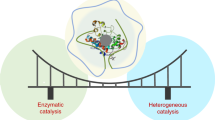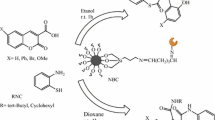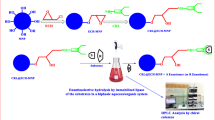Abstract
In this work, a nanohybrid material was developed and used for the first time to the kinetic resolution of secondary alcohols as rac-indanol, rac-1-phenylethanol (rac-1), rac-1-(3-bromophenyl)-1-ethanol (rac-2) and rac-1-(3-methylphenyl)-1-ethanol (rac-3). Chiral indanol is used as a precursor intermediate for the synthesis of enantiomeric drugs, such as (+)-Indatraline, Irindalone, Indinavir, (+)-Sertraline and Rasagiline mesylate. Chiral 1-phenylethanol is used as an ophthalmic preservative, a solvatochromic dye and an inhibitor of cholesterol absorption and as a mild floral fragrance. For this purpose, the ultrasound irradiation was used to couple APTES on the superparamagnetic nanoparticles surface. Then, the system was activated with glutaraldehyde and used as a support for immobilization of lipase from Pseudomonas fluorescens. Thermal stability analysis was performed in buffer and hexane, showing an excellent stability in buffer solution at 60 °C, holding 72% of the initial activity, even after 7 h. In hexane (40 °C), the immobilized enzyme retained 100% of activity with 693 min of half-life time at 50 °C. The high thermal stability is mainly related to the covalent bonding between enzymes and support. Immobilized lipase on magnetic support proved to be a robust biocatalyst in the kinetic resolution, leading to (S)-indanol with high selectivity (e.e. > 99%, E > 200) in 1.75 h at 50 °C, being reused five times without significant loss of the activity and selectivity. The kinetic resolution of rac-1, via acetylation reaction, catalyzed by lipase from Pseudomonas fluorescens immobilized on magnetic support, led to (R)-acetate with enantiomeric excess > 99% and to the remaining (S)-alcohol with enantiomeric excess of 94%, conversion of 49% and E > 200, after 48 h of reaction at 40 °C. Under the same reactions conditions, rac-2 and rac-3 were slightly less reactive, since the corresponding (R)-acetates were obtained with conversion values of 44%, but with high enantioselectivity (enantiomeric excesses > 99% and E values > 200). These results correspond to an important step in heterogeneous catalysis due to the ability to obtain important precursors for the synthesis of enantiomerically pure chiral drugs and other bioactive substances.






Similar content being viewed by others
Explore related subjects
Discover the latest articles and news from researchers in related subjects, suggested using machine learning.References
Vieira GAB, Araújo DMF, de Lemos TLG, de Mattos MC, de Oliveira MCFO, Melo VMM, de Gonzalo G, Gotor-Fernándex V, Gotor V (2010) Candida tropicalis CE017: a new Brazilian enzymatic source for the bioreduction of aromatic prochiral ketones. J Braz Chem Soc 21:1509–1516
Liu H, de Souza FZR, Liu L, Chen B-S (2018) The use of marine-derived fungi for preparation of enantiomerically pure alcohols. Appl Microbiol Biotechnol 102(3):1317–1330
Carvalho ACLdM, Fonseca TdS, Mattos MCd, Oliveira MdCFd, Lemos TLGd, Molinari F, Romano D, Serra I (2015) Recent advances in lipase-mediated preparation of pharmaceuticals and their intermediates. Int J Mol Sci 16(12):29682–29716
Vitale P, Perna FM, Agrimi G, Pisano I, Mirizzi F, Capobianco RV, Capriati V (2018) Whole-cell biocatalyst for chemoenzymatic total synthesis of rivastigmine. Catalysts 8(2):55
Hara N, Fujisawa S, Fujita M, Miyazawa M, Ochiai K, Katsuda S, Fujimoto T (2018) Kinetic resolution of sterically hindered secondary alcohols catalyzed by aminophosphinite organocatalyst. Tetrahedron 74(2):296–302
Todea A, Borza P, Cimporescu A, Paul C, Peter F (2017) Continuous kinetic resolution of aliphatic and aromatic secondary alcohols by sol–gel entrapped lipases in packed bed bioreactors. Catal Today 306:223
Gupta SM, Kamble MP, Yadav GD (2017) Insight into microwave assisted enzyme catalysis in process intensification of reaction and selectivity: kinetic resolution of (R, S)-flurbiprofen with alcohols. Mol Catal 440:50–56
Sikora A, Chełminiak-Dudkiewicz D, Ziegler-Borowska M, Marszałł MP (2017) Enantioseparation of (RS)-atenolol with the use of lipases immobilized onto new-synthesized magnetic nanoparticles. Tetrahedron Asymmet 28(2):374–380. https://doi.org/10.1016/j.tetasy.2017.01.012
Lee SH, Kim IS, Li QR, Dong GR, Jeong LS, Jung YH (2011) Stereoselective amination of chiral benzylic ethers using chlorosulfonyl isocyanate: total synthesis of (+)-sertraline. J Org Chem 76(24):10011–10019
Jiang Y, Zhang X, Mu H, Hua H, Duan D, Yan X, Wang Y, Meng Q, Lu X, Wang A (2018) Preparation and evaluation of injectable Rasagiline mesylate dual-controlled drug delivery system for the treatment of Parkinson’s disease. Drug Deliv 25(1):143–152
Kalaria DR, Singhal M, Patravale V, Merino V, Kalia YN (2018) Simultaneous controlled iontophoretic delivery of pramipexole and rasagiline in vitro and in vivo: transdermal polypharmacy to treat Parkinson’s disease. Eur J Pharm Biopharm 127:204–212
Chan HH, Tse MK, Kumar S, Zhuo L (2018) A novel selective MAO-B inhibitor with neuroprotective and anti-Parkinsonian properties. Eur J Pharmacol 818:254–262
Turner NJ, Kumar R (2018) Editorial overview: biocatalysis and biotransformation: the golden age of biocatalysis. Elsevier, New York City
Hughes G, Lewis JC (2018) Introduction: biocatalysis in industry. ACS Publications, Washington
Schmölzer K, Lemmerer M, Nidetzky B (2018) Glycosyltransferase cascades made fit for chemical production: integrated biocatalytic process for the natural polyphenol C-glucoside nothofagin. Biotechnol Bioeng 115(3):545–556
Baghban A, Heidarizadeh M, Doustkhah E, Rostamnia S, Rezaei PF (2017) Covalently bonded pancreatic lipase onto the dithiocarbamate/chitosan-based magnetite: stepwise fabrication of Fe3O4@CS/NHCS-lip as a novel and promising nanobiocatalyst. Int J Biol Macromol 103:1194–1200. https://doi.org/10.1016/j.ijbiomac.2017.05.159
Bornscheuer UT (2018) Enzymes in lipid modification. Annu Rev Food Sci Technol 9:85–103
Hama S, Noda H, Kondo A (2018) How lipase technology contributes to evolution of biodiesel production using multiple feedstocks. Curr Opin Biotechnol 50:57–64. https://doi.org/10.1016/j.copbio.2017.11.001
Elgharbawy AA, Riyadi FA, Alam MZ, Moniruzzaman M (2018) Ionic liquids as a potential solvent for lipase-catalysed reactions: a review. J Mol Liq 251:150–166. https://doi.org/10.1016/j.molliq.2017.12.050
Villalba M, Verdasco-Martín CM, dos Santos JC, Fernandez-Lafuente R, Otero C (2016) Operational stabilities of different chemical derivatives of Novozym 435 in an alcoholysis reaction. Enzyme Microb Technol 90:35–44
Verdasco-Martín CM, Villalba M, dos Santos JC, Tobajas M, Fernandez-Lafuente R, Otero C (2016) Effect of chemical modification of Novozym 435 on its performance in the alcoholysis of camelina oil. Biochem Eng J 111:75–86
Botton V, Piovan L, Meier HF, Mitchell DA, Cordova J, Krieger N (2018) Optimization of biodiesel synthesis by esterification using a fermented solid produced by Rhizopus microsporus on sugarcane bagasse. Bioprocess Biosyst Eng 41(4):573–583. https://doi.org/10.1007/s00449-018-1892-5
Dill LP, Kochepka DM, Krieger N, Ramos LP (2018) Synthesis of fatty acid ethyl esters with conventional and microwave heating systems using the free lipase B from Candida antarctica. Biocatal Biotransform. https://doi.org/10.1080/10242422.2018.1443079
Martin LS, Ceron A, Oliveira PC, Zanin GM, de Castro HF (2018) Different organic components on silica hybrid matrices modulate the lipase inhibition by the glycerol formed in continuous transesterification reactions. J Ind Eng Chem 62:462–470
Gardimalla HMR, Mandal D, Stevens PD, Yen M, Gao Y (2005) Superparamagnetic nanoparticle-supported enzymatic resolution of racemic carboxylates. Chem Commun 35:4432–4434. https://doi.org/10.1039/B504128G
Derewenda U, Swenson L, Green R, Wei Y, Yamaguchi S, Joerger R, Haas M, Derewenda Z (1994) Current progress, in crystallographic studies of new Upases from filamentous fungi. Protein Eng 7(4):551–557
Manoel EA, dos Santos JC, Freire DM, Rueda N, Fernandez-Lafuente R (2015) Immobilization of lipases on hydrophobic supports involves the open form of the enzyme. Enzyme Microb Technol 71:53–57
Manoel EA, Ribeiro MF, dos Santos JC, Coelho MAZ, Simas AB, Fernandez-Lafuente R, Freire DM (2015) Accurel MP 1000 as a support for the immobilization of lipase from Burkholderia cepacia: application to the kinetic resolution of myo-inositol derivatives. Process Biochem 50(10):1557–1564
Chen Y-Y, Tsai M-G, Chi M-C, Wang T-F, Lin L-L (2013) Covalent immobilization of Bacillus licheniformis γ-glutamyl transpeptidase on aldehyde-functionalized magnetic nanoparticles. Int J Mol Sci 14(3):4613–4628
Zdarta J, Meyer AS, Jesionowski T, Pinelo M (2018) A general overview of support materials for enzyme immobilization: characteristics, properties, practical utility. Catalysts 8(2):92
DiCosimo R, McAuliffe J, Poulose AJ, Bohlmann G (2013) Industrial use of immobilized enzymes. Chem Soc Rev 42(15):6437–6474
Sharifi M, Robatjazi S-M, Sadri M, Mosaabadi JM (2018) Covalent immobilization of organophosphorus hydrolase enzyme on chemically modified cellulose microfibers: statistical optimization and characterization. React Funct Polym 124:162–170
de Souza TC, Fonseca TdS, da Costa JA, Rocha MVP, de Mattos MC, Fernandez-Lafuente R, Gonçalves LR, dos Santos JC (2016) Cashew apple bagasse as a support for the immobilization of lipase B from Candida antarctica: application to the chemoenzymatic production of (R)-Indanol. J Mol Catal B Enzym 130:58–69
de Sousa Fonseca T, da Silva MR, de Oliveira MdCF, de Lemos TLG, de Araújo Marques R, de Mattos MC (2015) Chemoenzymatic synthesis of rasagiline mesylate using lipases. Appl Catal A 492:76–82
Atacan K, Özacar M, Özacar M (2018) Investigation of antibacterial properties of novel papain immobilized on tannic acid modified Ag/CuFe2O4 magnetic nanoparticles. Int J Biol Macromol 109:720–731
Zhang L, Wang B, Wang S, Zhang W (2018) Recyclable trypsin immobilized magnetic nanoparticles based on hydrophilic polyethylenimine modification and their proteolytic characteristics. Anal Methods 10:459–466
Mandai K, Fukuda T, Miyazaki Y, Hashimoto H, Mandai H, Ema T, Takada J, Suga S (2017) Magnetic attachment of lipase immobilized on bacteriogenic iron oxide inside a microtube reactor for the kinetic resolution of secondary alcohols. Synlett. https://doi.org/10.1055/s-0036-1589953
Galvão WS, Neto D, Freire RM, Fechine P Super-paramagnetic nanoparticles with spinel structure: a review of synthesis and biomedical applications. in: solid state phenomena, 2015. Trans Tech Publ, pp 139–176
Galvao W, Freire R, Ribeiro T, Vasconcelos I, Costa L, Freire V, Sales F, Denardin JC, Fechine P (2014) Cubic superparamagnetic nanoparticles of NiFe2O4 via fast microwave heating. J Nanopart Res 16(12):2803
Simonsen G, Strand M, Øye G (2018) Potential applications of magnetic nanoparticles within separation in the petroleum industry. J Pet Sci Eng 165:488
Abu-Dief AM, Abdel-Fatah SM (2018) Development and functionalization of magnetic nanoparticles as powerful and green catalysts for organic synthesis. Beni-Suef Univ J Basic Appl Sci 7:55–67. https://doi.org/10.1016/j.bjbas.2017.05.008
Patil KC, Hegde MS, Rattan T, Aruna ST (2008) Nanocrystalline Fe2O3 and ferrites. In: Chemistry of nanocrystalline oxide materials—Combustion synthesis, properties and applications, pp 154–178
Santos JCSd, Barbosa O, Ortiz C, Berenguer-Murcia A, Rodrigues RC, Fernandez-Lafuente R (2015) Importance of the support properties for immobilization or purification of enzymes. ChemCatChem 7(16):2413–2432
Shi Y, Jia L, Du Q, Niu J, Zhang D (2018) Surface-modified PLGA nanoparticles with chitosan for oral delivery of tolbutamide. Colloids Surf B 161:67–72
Sun M, Cheng G, Ge X, Chen M, Wang C, Lou L, Xu X (2017) Aqueous Hg(II) immobilization by chitosan stabilized magnetic iron sulfide nanoparticles. Sci Total Environ 621:1074
Illés E, Szekeres M, Tóth IY, Szabó Á, Iván B, Turcu R, Vékás L, Zupkó I, Jaics G, Tombácz E (2018) Multifunctional PEG-carboxylate copolymer coated superparamagnetic iron oxide nanoparticles for biomedical application. J Magn Magn Mater 451:710–720
Hu J, Youssefian S, Obayemi J, Malatesta K, Rahbar N, Soboyejo W (2018) Investigation of adhesive interactions in the specific targeting of triptorelin-conjugated PEG-coated magnetite nanoparticles to breast cancer cells. Acta Biomater 71:363–378
Jones ST, Walsh-Korb Z, Barrow SJ, Henderson SL, del Barrio J, Scherman OA (2016) The importance of excess poly (N-isopropylacrylamide) for the aggregation of poly (N-isopropylacrylamide)-coated gold nanoparticles. ACS Nano 10(3):3158–3165
Feng J, Yu S, Li J, Mo T, Li P (2016) Enhancement of the catalytic activity and stability of immobilized aminoacylase using modified magnetic Fe3O4 nanoparticles. Chem Eng J 286:216–222
Gil S, Correia CR, Mano JF (2015) Magnetically labeled cells with surface-modified Fe3O4 spherical and rod-shaped magnetic nanoparticles for tissue engineering applications. Adv Healthcare Mater 4(6):883–891
Rostamnia S, Gholipour B, Liu X, Wang Y, Arandiyan H (2018) NH2-coordinately immobilized tris(8-quinolinolato)iron onto the silica coated magnetite nanoparticle: Fe3O4@SiO2-FeQ3 as a selective Fenton-like catalyst for clean oxidation of sulfides. J Colloid Interface Sci 511:447–455. https://doi.org/10.1016/j.jcis.2017.10.028
Barreto A, Maia F, Santiago V, Ribeiro V, Denardin JC, Mele G, Carbone L, Lomonaco D, Mazzetto S, Fechine P (2012) Novel ferrofluids coated with a renewable material obtained from cashew nut shell liquid. Microfluid Nanofluid 12(5):677–686
Murugappan G, Zakir MJA, Jayakumar GC, Khambhaty Y, Sreeram KJ, Rao JR (2016) A novel approach to enzymatic unhairing and fiber opening of skin using enzymes immobilized on magnetite nanoparticles. ACS Sustain Chem Eng 4(3):828–834
Kim DK, Dobson J (2009) Nanomedicine for targeted drug delivery. J Mater Chem 19(35):6294–6307
Bele A, Cazacu M, Racles C, Stiubianu G, Ovezea D, Ignat M (2015) Tuning the electromechanical properties of silicones by crosslinking agent. Adv Eng Mater 17:1302–1312
Zhao W, Cui B, Peng H, Qiu H, Wang Y (2015) Novel method to investigate the interaction force between etoposide and APTES-functionalized Fe3O4@ nSiO2@ mSiO2 nanocarrier for drug loading and release processes. J Phys Chem C 119(8):4379–4386
Vashist SK, Schneider EM, Lam E, Hrapovic S, Luong JH (2014) One-step antibody immobilization-based rapid and highly-sensitive sandwich ELISA procedure for potential in vitro diagnostics. Sci Rep 4:4407
Morris AS, Adamcakova-Dodd A, Lehman SE, Wongrakpanich A, Thorne PS, Larsen SC, Salem AK (2016) Amine modification of nonporous silica nanoparticles reduces inflammatory response following intratracheal instillation in murine lungs. Toxicol Lett 241:207–215
Peixoto AF, Fernandes AC, Pereira C, Pires J, Freire C (2016) Physicochemical characterization of organosilylated halloysite clay nanotubes. Microporous Mesoporous Mater 219:145–154
Saengdee P, Chaisriratanakul W, Bunjongpru W, Sripumkhai W, Srisuwan A, Jeamsaksiri W, Hruanun C, Poyai A, Promptmas C (2015) Surface modification of silicon dioxide, silicon nitride and titanium oxynitride for lactate dehydrogenase immobilization. Biosens Bioelectron 67:134–138
Donadelli JA, Einschlag FSG, Laurenti E, Magnacca G, Carlos L (2018) Soybean peroxidase immobilized onto silica-coated superparamagnetic iron oxide nanoparticles: effect of silica layer on the enzymatic activity. Colloids Surf B 161:654–661
Zhang L, Sun Y (2018) Poly (carboxybetaine methacrylate)-grafted silica nanoparticle: a novel carrier for enzyme immobilization. Biochem Eng J 132:122
Zhang L-S, Fang Y, Zhou Y, Ye B-C (2017) Improvement of the stabilization and activity of protocatechuate 3, 4-dioxygenase isolated from Rhizobium sp. LMB-1 and Immobilized on Fe3O4 nanoparticles. Appl Biochem Biotechnol 183(3):1035–1048. https://doi.org/10.1007/s12010-017-2481-9
Bradford MM (1976) A rapid and sensitive method for the quantitation of microgram quantities of protein utilizing the principle of protein-dye binding. Anal Biochem 72(1):248–254
Andrade LH, Rebelo LP, Netto CGCM, Toma HE (2010) Kinetic resolution of a drug precursor by Burkholderia cepacia lipase immobilized by different methodologies on superparamagnetic nanoparticles. J Mol Catal B Enzym 66(1):55–62
Bhatnagar T, Boutaiba S, Hacene H, Cayol J-L, Fardeau M-L, Ollivier B, Baratti JC (2005) Lipolytic activity from Halobacteria: screening and hydrolase production. FEMS Microbiol Lett 248(2):133–140
Rios NS, Pinheiro MP, dos Santos JCS, Fonseca TdS, Lima LD, de Mattos MC, Freire DM, da Silva IJ, Rodríguez-Aguado E, Gonçalves LR (2016) Strategies of covalent immobilization of a recombinant Candida antarctica lipase B on pore-expanded SBA-15 and its application in the kinetic resolution of (R, S)-Phenylethyl acetate. J Mol Catal B Enzym 133:246–258
Sadana A, Henley JP (1987) Analysis of enzyme deactivations by a series-type mechanism. Ann N Y Acad Sci 501(1):73–79
Widder KJ, Senyel AE, Scarpelli GD (1978) Magnetic microspheres: a model system of site specific drug delivery in vivo. Proc Soc Exp Biol Med Soc Exp Biol Med (New York, NY) 158:141–146
Rietveld H (1969) A profile refinement method for nuclear and magnetic structures. J Appl Crystallogr 2(2):65–71
Santos CO (2006) Aplicações do Método de Rietveld. Instituto de Química, Unesp
Sawabe T, Yano T (2008) Neutron irradiation effect on site distribution of cations in non-stoichiometric magnesium aluminate spinel. J Nucl Mater 373:328–334. https://doi.org/10.1016/j.jnucmat.2007.06.013
Freire R, Ribeiro T, Vasconcelos I, Denardin J, Barros E, Mele G, Carbone L, Mazzetto S, Fechine P (2013) MZnFe2O4 (M = Ni, Mn) cubic superparamagnetic nanoparticles obtained by hydrothermal synthesis. J Nanopart Res 15(5):1–12
Holzwarth U, Gibson N (2011) The Scherrer equation versus the’Debye–Scherrer equation’. Nat Nanotechnol 6(9):534
de Moura CVnR, de Castro AG, de Moura EM, dos Santos JR, Moita Neto JM (2010) Heterogeneous catalysis of babassu oil monitored by thermogravimetric analysis. Energy Fuels 24:6527–6532. https://doi.org/10.1021/ef101228f
Park J, An K, Hwang Y, Park J-G, Noh H-J, Kim J-Y, Park J-H, Hwang N-M, Hyeon T (2004) Ultra-large-scale syntheses of monodisperse nanocrystals. Nat Mater 3(12):891–895
Mendes AA, de Castro HF, Rodrigues DdS, Adriano WS, Tardioli PW, Mammarella EJ, Giordano RdC, de LC Giordano R (2011) Multipoint covalent immobilization of lipase on chitosan hybrid hydrogels: influence of the polyelectrolyte complex type and chemical modification on the catalytic properties of the biocatalysts. J Ind Microbiol Biotechnol 38(8):1055–1066
Rueda N, dos Santos JC, Ortiz C, Barbosa O, Fernandez-Lafuente R, Torres R (2016) Chemical amination of lipases improves their immobilization on octyl-glyoxyl agarose beads. Catal Today 259:107–118
Sanchez A, Cruz J, Rueda N, dos Santos JC, Torres R, Ortiz C, Villalonga R, Fernandez-Lafuente R (2016) Inactivation of immobilized trypsin under dissimilar conditions produces trypsin molecules with different structures. RSC Adv 6(33):27329–27334
Kim M-J, Kim HM, Kim D, Ahn Y, Park J (2004) Dynamic kinetic resolution of secondary alcohols by enzyme–metal combinations in ionic liquid. Green Chem 6(9):471–474
Kazlauskas RJ, Weissfloch AN, Rappaport AT, Cuccia LA (1991) A rule to predict which enantiomer of a secondary alcohol reacts faster in reactions catalyzed by cholesterol esterase, lipase from Pseudomonas cepacia, and lipase from Candida rugosa. J Org Chem 56(8):2656–2665
Chênevert R, Pelchat N, Morin P (2009) Lipase-mediated enantioselective acylation of alcohols with functionalized vinyl esters: acyl donor tolerance and applications. Tetrahedron Asymmetry 20(10):1191–1196
Matharu DS, Morris DJ, Kawamoto AP, Clarkson GJ, Wills M (2006) A Stereochemically well-defined rhodium(III) catalyst for asymmetric transfer hydrogenation of ketones. Org Lett 7(24):5489–5491
Päiviö M, Mavrynsky D, Leino R, Kanerva LT (2011) Dynamic kinetic resolution of a wide range of secondary alcohols: cooperation of dicarbonylchlorido(pentabenzylcyclopentadienyl)ruthenium and CAL-B. Eur J Org Chem 8:1452–1457
Martins JED, Redondo MAC, Wills M (2010) Applications of N’-alkylated derivatives of TsDPEN in the asymmetric transfer hydrogenation of C = O and C = N bonds. Tetrahedron Asymmetry 21(18):2258–2264
Kim M-J, Kim HM, Kim D, Ahn Y, Park J (2004) Dynamic kinetic resolution of secondary alcohols by enzyme–metal combinations in ionic liquid. Green Chem 6:471–474
Acknowledgements
We gratefully acknowledge the financial support of Brazilian Agencies for Scientific and Technological Development CAPES, Funcap (PNE-0112-00048.01.00/16) and CNPq (408790/2016-4). The authors thank the Laboratório de Raios X and Laboratório de Produtos e Tecnologia de Processos (LPT) of the Universidade Federal do Ceará for the experiments and analyses. We also acknowledge Brazilian Nanotechnology National Laboratory (LNNano) for the access to electron microscopy facilities.
Author information
Authors and Affiliations
Corresponding author
Rights and permissions
About this article
Cite this article
Galvão, W.S., Pinheiro, B.B., Golçalves, L.R.B. et al. Novel nanohybrid biocatalyst: application in the kinetic resolution of secondary alcohols. J Mater Sci 53, 14121–14137 (2018). https://doi.org/10.1007/s10853-018-2641-5
Received:
Accepted:
Published:
Issue Date:
DOI: https://doi.org/10.1007/s10853-018-2641-5




